Solid oxide fuel cell assembly with replaceable stack and packet modules
- Summary
- Abstract
- Description
- Claims
- Application Information
AI Technical Summary
Benefits of technology
Problems solved by technology
Method used
Image
Examples
example 1
[0158] A framed packet assembly for use in a fuel cell stack is constructed from steel framing members and multi-cell-sheet devices in accordance with a stack assembly design substantially similar to that illustrated in FIGS. 6-11 of the drawings. First prepared are 3 / 16″-thick frames of Type 446 stainless steel, these frames being machined to provide a fuel packet frame and a pair of air frames incorporating inlet channels, orifices and air or fuel chambers substantially as described.
[0159] To the machined fuel frame thus provided are next attached a pair of multi-cell-sheet devices. The devices selected for this attachment consist of flexible 12 cm by 15 cm electrolyte sheets of 3 mol % Y2O3-partially-stabilzed ZrO2 composition provided with a total of 540 via holes. Onto the first or anode sides of each of these sheets are deposited arrays of 10 anodes, each consisting of 6-micron-thick Ni / ZrO2 catalyst layers and 20-micron-thick layers of ceramic-powder-filled 90% Ag / 10% Pd sil...
example 2
[0169] A four-cell packet incorporating a partially stabilized zirconia (zirconia —3 mole % yttria) electrolyte support sheet, similar in configuration to the packet depicted in FIG. 1 of the drawings, is first provided. With reference to FIG. 1, to provide this packet 10 a first pre-sintered zirconia—3 mole % yttria electrolyte sheet 12 of approximate dimensions 10 cm×6 cm and supporting 4 pairs of silver / palladium alloy electrodes 16-16a is fastened to the top edge of a second pre-sintered zirconia—3 mole % yttria electrolyte sheet 14 as a backing sheet. Fastening is by means of an edge seal 18 formed from a 70:30 (parts by weight) of 230 Duralco:954 Durabond cement mixture, a commercially available material.
[0170] Each alloy electrode pair 16-16a attached to the first sheet includes an interior fuel electrode or anode 16a and an exterior air electrode or cathode 16, these being in largely overlapping positions on opposing sides of the sheet. Each of these electrodes is approxima...
example 3
[0176] An eight-cell packet comprising 8 anode-cathode pairs with each electrode having a width of about 3 mm and a length of about 8 cm is prepared as described in Example 1. The electrolyte support sheet consists of a flexible zirconia—3 mole % yttria ceramic sheet about 25 micrometers in thickness. To increase the surface roughness of the sheet for reduce electrode interfacial resistance, a thin film of yittria-stabilized zirconia nano-crystals is applied to the surface of the sheet by spraying the sheet with a yttria-zirconia sol while heating the sheet on a hot plate.
[0177] The electrodes are applied to the surfaces of the thus-coated sheet by silk-screening, being formed of the zirconia-filled silver-palladium alloy employed in Example I. Vias through the sheet for the series interconnection of the electrode pairs as in Example I are formed of the same silver palladium alloy.
[0178] A flexible packet backing sheet formed of zirconia—3 mole % yttria ceramic is then provided, t...
PUM
 Login to View More
Login to View More Abstract
Description
Claims
Application Information
 Login to View More
Login to View More - R&D
- Intellectual Property
- Life Sciences
- Materials
- Tech Scout
- Unparalleled Data Quality
- Higher Quality Content
- 60% Fewer Hallucinations
Browse by: Latest US Patents, China's latest patents, Technical Efficacy Thesaurus, Application Domain, Technology Topic, Popular Technical Reports.
© 2025 PatSnap. All rights reserved.Legal|Privacy policy|Modern Slavery Act Transparency Statement|Sitemap|About US| Contact US: help@patsnap.com



